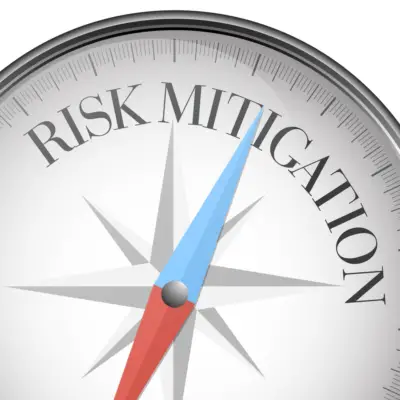For any business to thrive in today’s intensely competitive environment, a robust risk-management strategy is not just an asset—it’s a necessity.
Project Risk Mitigation is a crucial element in this strategy, enabling enterprises to navigate potential downsides and maximize business potential.
This article provides a multifaceted view of Project Risk Mitigation, encompassing its very essence, the tools and techniques for its practical application, and its enduring effect on building sustainable businesses.
Digesting this knowledge, readers will secure a clear insight into the nature, characteristics, and role of Project Risk Mitigation and how it can foster a safer, more secure, and thriving business environment.
Understanding the Essence of Project Risk Mitigation
Project risk mitigation – a phrase that might sound as thrilling as watching paint dry, but ignoring it can place your entrepreneurial endeavours on hold faster than you can say “business failure”.
The understanding and execution of robust risk mitigation strategies are instrumental in fueling the success of any enterprise. For savvy, forward-thinking entrepreneurs, these basic concepts of project risk mitigation should be front-of-mind in every venture undertaken.
So, perhaps you’re thinking, what is project risk mitigation? In simple terms, it’s the blueprint of your action plan to identify, assess, and mitigate the potential risks that may impact the successful completion of a project.
It’s the safety net, ensuring that should Murphy’s Law come into play, your business won’t crumble into a pile of unmet deliverables and lost revenue.
To navigate uncertain business climates and project outcomes, four operational principles of risk mitigation should be your entrepreneurial compass. These principles include risk identification, analysis, prioritisation, and treatment.
The first step, risk identification, is as simple as it sounds, but its depth is not to be underestimated. This involves a deep dive into potential risks from both internal and external sources. Ask the hard questions and be brutally realistic about factors that could derail you.
Up next is risk analysis. This implies a detailed understanding of the identified risks and their potential impact. By quantifying the risks, you give yourself a realistic assessment of potential damage.
The third stage, risk prioritization, is built on a comprehensive understanding of the analysed risks. Here, risks are ranked based on their potential impact and frequency of occurrence. Attention must be focused on high-impact and high-frequency risks.
Finally, the risk treatment phase outlines the procedures to reduce, avoid, or transfer the risks. Each risk should have an associated response plan documented and reviewed regularly to maintain relevancy. This is the action arm of the risk mitigation strategy.
Now, with this core insight into project risk mitigation, remember: that risk is not necessarily a harbinger of doom. In the ever-evolving world of business, risk is an inherent element. Bear in mind, though, that a risk-taker and a calculated risk-taker are two distinct breeds in the entrepreneurial ecosystem.
Learning the art of project risk management equips you with an effective shield against potentially catastrophic missteps. So, embrace risk mitigation as a core pillar of your enterprise.
Entrepreneurs who succeed aren’t those who never fail, they’re those who never let the risk of failure stop them from moving forward.

Identifying and Evaluating Project Risks
Building upon the framework of project risk mitigation in entrepreneurial efforts, let’s shift gears and delve deeper into the active role of the entrepreneur in making these principles work.
Just as an architect needs blueprints to bring a building to life, entrepreneurs need a detailed plan for risk mitigation. In sharpening this tool, entrepreneurs don’t abstain from risks but learn to master them.
Being a calculated risk-taker means you perform due diligence to foresee, analyze, and effectively manage those risks that may occur throughout the project life cycle.
Identifying risks early on is of paramount importance. The first step is accurately pinpointing sources of risk within your operating environment.
It follows a wide-angle approach, going beyond the immediate project and encompassing sectors like market trends, technology evolutions, shifts in customer behavior, and competitive activities.
Acknowledge that risks can sprout from any corner of your business terrain. A common mistake is fixating solely on known risks neglecting the potential unknown risks. Adopt an expansive, curious mindset that continually scans for possible threats.
After identification, classification of the identified risks is the next step. Categorize them based on factors such as likelihood of occurrence, potential impact, or domain (financial, legal, market etc). This allows for easier management and targeted strategies for each risk category.
Moving on, evaluating risks requires a mix of subjective judgements and objective data. Here, we dive into impact analysis, where the repercussions of each risk are measurably analyzed.
Metrics to consider could include loss of revenue, operational hindrances, damage to brand reputation, or regulatory penalties. This quantitative assessment shows the potential harm the risk could inflict if left untreated.
Next up is risk prioritization. This isn’t akin to daily to-do lists. Prioritizing risks requires a fine balance between the likelihood of risk occurrence and its potential impact on the project’s outcome.
Not all risks dictate immediate action. Some may be managed through monitoring and contingencies. High-impact and high-likelihood ones, however, demand swift and decisive action.
Lastly, we have risk treatment. This is where proactive measures take place. The aim is to control the impact and the likelihood of the risk.
Risk treatment strategies include risk avoidance, reduction, sharing, and retention. Optimal risk treatments should align with your project’s goals, resources, and overall strategy.
Managing risks doesn’t imply eliminating all risks; it means effectively managing them to minimize potential negative impacts.
Risk identification, classification, evaluation, and prioritization are key steps in cutting through the fog surrounding potential project pitfalls.
This meticulous analysis process moulds entrepreneurs into steward leaders who can steer their venture through stormy seas to safe harbour. It compartmentalizes risks, quantifies their effects, and empowers leaders to make well-informed, tactical decisions.
Let’s remember that risk mitigation is not a one-off task. It becomes an integrated system looping feedback into each step of the chain, refining the process and strengthening the shield.
After all, the mark of entrepreneur success isn’t just about reaching the end line but also about how they navigated the hurdles along the road. Remember, it isn’t about avoiding risks, it’s about managing them successfully.

Strategies for Active Project Risk Mitigation
Peering through the lens of entrepreneurship, we recognize that venture landscapes are never devoid of risks. Project risk mitigation comes to the forefront as a crucial, modern-day tool to navigate these capricious terrains.
Having already established the grounding principles, let us journey towards grasping essential strategies to arm entrepreneurs with the prowess of mitigating project risks.
1. Relevance of Risk Communication:
A subsequent strategy, following identification, analysis, and prioritization, is the timely communication of these risks. This proactive disclosure aligns the team, creating a shared understanding of the potential challenges lurking in the project vistas.
2. Risk Monitoring:
An often neglected but crucial strategy is maintaining vigilance over project risks at all stages. By spotting alterations and developments in risk patterns, we can pre-emptively tackle risks before they bloom into substantial problems.
3. Risk Contingency Planning:
Even the most calculated ventures house inevitable uncertainties. Thus, forming contingency plans for identified risks can bolster resilience and serve as a buffer, ensuring project continuity despite unforeseen adversities.
4. Stakeholder Engagement:
Engaging stakeholders in the risk mitigation process ensures transparency and builds trust. They, in turn, can provide unique perspectives and strategies, thereby enhancing the risk management framework.
5. Tailoring Risk Responses:
Every project is a unique entity, as are its associated risks. Crafting custom responses, as against generic solutions, is instrumental in effective risk treatment. This tailor-made approach upholds the assertion of entrepreneurship as art and not just a monotonous protocol.
6. Utilizing Risk Management Tools:
Available tech tools can simplify and streamline the gambit of risk mitigation. From risk mapping to risk evaluation algorithms, these tools enhance precision and efficiency in managing risks.
7. Risk Mitigation Training:
Equipping the project team with apt knowledge and skills for risk handling is crucial. Regular training sessions bring about a common understanding and consensus in dealing with risks.
8. Regular Risk Audits:
In the dynamic realm of projects, risks can morph or multiply swiftly. Regular audits can help track and trace such risks, enabling swift and suitable responses.
9. Project Review Post-Completion:
Conducting a comprehensive project review post-completion brings insights and lessons. These can be leveraged in future projects, strengthening the risk management framework.
10. Foster a Culture of Learning:
Heightening the individual and organizational learning curve is key. By cultivating a culture open to learning from errors, we can transmute them into opportunities, nurturing a stronger, risk-resilient organization.
Risk mitigation is more than a mechanical exercise; it is an art form that necessitates strategizing and intuitive decision-making.
These ten strategies can serve as stepping stones in the odyssey towards a risk-resilient organization, ushering in an era of surviving risks and thriving amidst them.

Sustaining Successful Risk Mitigation Beyond Project Closure
Risk communication is crucial in maintaining a successful risk mitigation strategy beyond individual projects. It involves continuously informing all stakeholders, including employees, partners, and investors, about the potential risks and the implemented strategies to mitigate them.
Informed stakeholders lead to better decision-making, foster trust, and prevent any unexpected setbacks.
Next on the line is risk monitoring, an often overlooked but absolutely critical aspect of risk mitigation. Regular monitoring helps not only to assess the effectiveness of the mitigation strategies implemented but also to identify any new risks that arise. With dynamic market trends and shifting customer preferences, risks evolve, and businesses must stay vigilant.
Contingency planning links directly with risk monitoring. It involves developing flexible plans that can handle potential risks should they manifest. Businesses can ensure continuity by implementing backup strategies.
Stakeholder engagement is a secret sauce that can make or break a business’ risk mitigation strategy. Encouraging involvement at all levels fosters multi-perspective views on potential risks and possible solutions for mitigation.
Allowing your stakeholders to voice their thoughts and concerns can promote proactive risk management, opening dialogues to innovative solutions that might otherwise go unseen.
Tailoring risk responses is vital. There is a myriad of possible risks, and not all warrant the same response. For example, a high-impact but low-probability risk might require a different approach to a high-likelihood, low-impact risk.
Therefore, customizing responses to fit the nature of the risk can greatly enhance the business’s resilience in the face of adversity.
Modern technology provides a variety of advanced risk management tools that can automate risk identification, analyze risk factors, and even provide predictive analysis of potential risks.
Adopting these tools can significantly enhance the efficiency and effectiveness of a business’s risk mitigation implementation.
Risk mitigation is not just a task but rather a skill. And like any skill, it can be honed with proper training. Regular risk mitigation training can equip the team with the necessary skills to identify, assess and respond accordingly to potential risks.
A regular risk audit is equally important as it objectively reviews the current risk management practice. This provides insight into areas that require improvement, the efficiency of current strategies, and validation of the effectiveness of implemented risk mitigation measures.
Post-project review is a powerful learning tool. It allows learning from past experiences – both positive and negative. By retrospectively examining established risk mitigation strategies, businesses can understand what worked and what needs to be enhanced.
Last but certainly not least is to foster a culture of learning and adaption. Risk mitigation isn’t just about putting out fires.
Rather, it’s about creating an environment where discussion about vulnerabilities, making educated decisions and utilizing data to drive risk-reducing behaviors become an ingrained part of the business’s DNA.
Keep in mind that risk is a natural part of entrepreneurship. However, it doesn’t mean businesses must accept all incoming threats passively.
Active risk mitigation is the way to guarantee the seal of success is perpetually stamped on every endeavour, by every entrepreneur.
A well-planned risk mitigation strategy not only safeguards your business from fallout, it paves the path for agile growth and sustainability.

Conclusion
In the world of project management, risks are omnipresent, and the art of mitigating these risks separates thriving businesses from fragile ones.
The principles, strategies, and processes discussed are instrumental in designing a comprehensive risk mitigation plan.
Our discussion on sustaining successful risk mitigation beyond project closure reiterates the need for businesses to go beyond treating mitigation as a project-level necessity.
It is about integrating risk-conscious perspectives into everyday business narratives, fostering resilience, and driving growth.
May this knowledge help you confidently navigate the risky waters of business and usher in a culture of dexterity and potency in your organization. Remember, a well-mitigated risk is a well-managed opportunity.

Chris Ekai is a Risk Management expert with over 10 years of experience in the field. He has a Master’s(MSc) degree in Risk Management from University of Portsmouth and is a CPA and Finance professional. He currently works as a Content Manager at Risk Publishing, writing about Enterprise Risk Management, Business Continuity Management and Project Management.

